Knowledge Discovery & Representation
Download as pptx, pdf0 likes262 views
The document discusses knowledge discovery and data mining. It describes knowledge discovery as automatically searching large volumes of data for patterns that can be considered knowledge. The document outlines the five steps of the knowledge discovery process and notes it is closely related to data mining. It then discusses data mining, describing the purpose, preference, and search techniques used in data mining algorithms. The document also categorizes data mining and describes how it provides links between transactional and analytical systems to analyze relationships and patterns in stored data.
1 of 19
Download to read offline
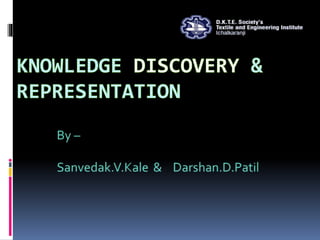
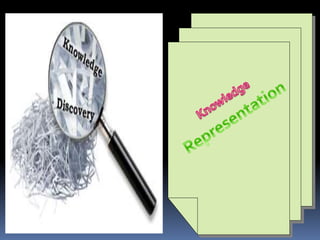
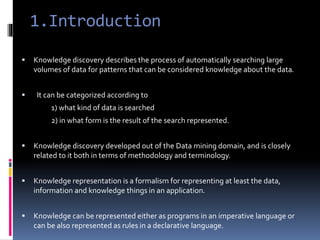
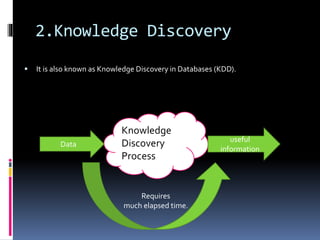
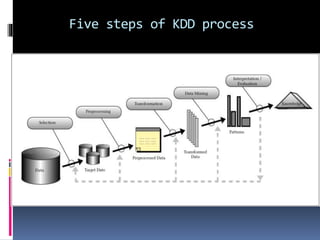

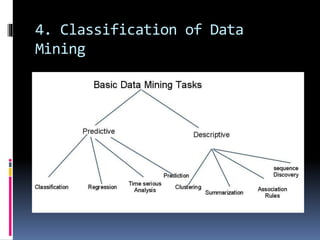
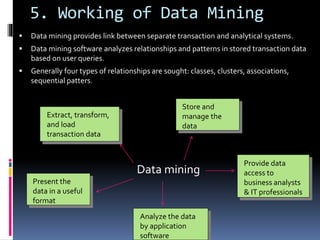

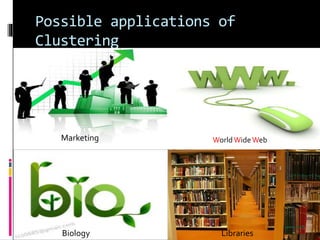

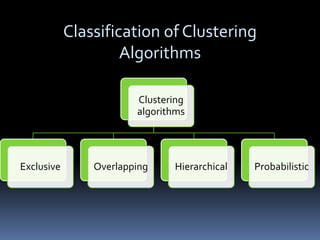
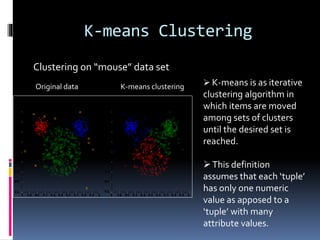
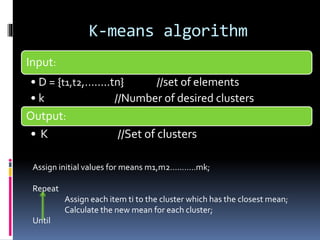
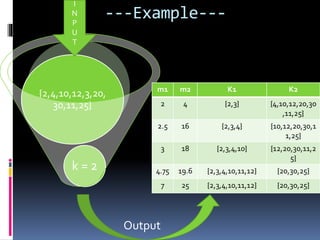




Ad
Recommended
Data Mining and Knowledge
Data Mining and KnowledgeKartik Kalpande Patil
╠²
Data mining is the process of discovering patterns in large data sets and is a core part of the knowledge discovery process. It involves preprocessing, transforming, and mining data to extract useful patterns. Main data mining tasks include classification, association rule mining, clustering, sequential pattern mining, and deviation detection. The goal is to extract valid, novel, useful, and understandable patterns that can be interpreted into knowledge through an iterative and interactive process.Illustrative approach-of-data-mining
Illustrative approach-of-data-mininggufranresearcher
╠²
This document provides an introduction and overview of data mining techniques. It defines data mining as the process of discovering useful knowledge and patterns from large amounts of data. The document outlines the basic data mining process of data extraction, transformation, loading, analysis, and interpretation. It then describes three common data mining techniques: association, which finds hidden relationships among data; classification, which categorizes unknown data into known classes; and clustering, which groups data without predefined classes based on similarity. The document encourages further exploration of data mining techniques on the web.Data Mining: Classification and analysis
Data Mining: Classification and analysisDataminingTools Inc
╠²
Data mining involves classification, cluster analysis, outlier mining, and evolution analysis. Classification models data to distinguish classes using techniques like decision trees or neural networks. Cluster analysis groups similar objects without labels, while outlier mining finds irregular objects. Evolution analysis models changes over time. Data mining performance considers algorithm efficiency, scalability, and handling diverse and complex data types from multiple sources.Data mining
Data miningsnegacmr
╠²
The document discusses three main issues in data integration: schema integration, redundancy, and detection and resolution of data value conflicts. It also discusses data preprocessing techniques used to transform raw data into a useful format, including handling missing and noisy data. The key steps of data preprocessing are data cleaning, handling missing data by ignoring tuples or filling missing values, and resolving noisy data.G045033841
G045033841IJERA Editor
╠²
The document discusses the significance of data mining as a tool for analyzing large and complex datasets, explaining its various applications and challenges in different fields. It outlines the data mining process, which includes steps such as data cleaning, integration, transformation, and mining, leading to pattern evaluation and knowledge representation. Various data types and mining tasks, such as classification, clustering, and prediction, are also highlighted, emphasizing the need for robust data mining systems to uncover hidden patterns in data.Data mining tasks
Data mining tasksKhwaja Aamer
╠²
This document discusses data mining and different types of data mining techniques. It defines data mining as the process of analyzing large amounts of data to discover patterns and relationships. The document describes predictive data mining, which makes predictions based on historical data, and descriptive data mining, which identifies patterns and relationships. It also discusses classification, clustering, time-series analysis, and data summarization as specific data mining techniques.IRJET- Cluster Analysis for Effective Information Retrieval through Cohesive ...
IRJET- Cluster Analysis for Effective Information Retrieval through Cohesive ...IRJET Journal
╠²
This document discusses using document clustering to improve information retrieval systems. It proposes a framework with four steps: 1) the information retrieval system retrieves documents based on a user query, 2) a similarity measure is used to determine document similarity, 3) the documents are clustered based on similarity, and 4) the clusters are ranked based on relevance to the query. The goal of clustering is to group relevant documents together to help users more easily find needed information. Different clustering algorithms are reviewed, noting that hierarchical clustering and overlapping clusters may improve search results over other methods.Data Cleaning Techniques
Data Cleaning TechniquesAmir Masoud Sefidian
╠²
The document discusses various data cleaning techniques essential for ensuring data quality in information systems, highlighting methods such as DWcleanser for detecting approximate duplicates and employing data quality mining with association rules and functional dependencies. An enhanced algorithm for cleaning data warehouses is presented, focusing on accuracy and efficiency in correcting errors, as well as a systematic approach for managing metadata and outlier records. The frameworks and techniques described aim to address common data quality issues while minimizing processing time and improving overall data integrity.Emerging domain agnostic functionalities on the handle-centered networks
Emerging domain agnostic functionalities on the handle-centered networksNational Institute of Informatics
╠²
1) The document discusses emerging domain-agnostic capabilities for automatic data processing on a PID-centric information model using Kernel Information metadata.
2) Kernel Information defines structural relationships between data, data types, and properties that enables domain-independent analysis and recommendations.
3) Handle-centered networks built on the Kernel Information metadata layer can provide domain-agnostic functionalities through graph-based reasoning across scientific data.Simple and Flexible DHTs
Simple and Flexible DHTsLuis Gal├Īrraga
╠²
The document outlines the design and benefits of a flexible distributed hash table (DHT) approach, which aims to balance simplicity and flexibility by incorporating type awareness and extended access semantics. It discusses using type and key policies to improve data handling and offers various applications like version control, image storage, and access control while addressing design challenges such as consistency and safety. The research emphasizes the potential for enhanced extensibility and performance with minimal impact on development complexity.data mining
data miningmanasa polu
╠²
This document provides an introduction to data mining. It defines data mining as the process of extracting knowledge from large amounts of data. The document outlines the typical steps in the knowledge discovery process including data cleaning, transformation, mining, and evaluation. It also describes some common challenges in data mining like dealing with large, high-dimensional, heterogeneous and distributed data. Finally, it summarizes several common data mining tasks like classification, association analysis, clustering, and anomaly detection.Basic terminologies
Basic terminologiesRajendran
╠²
This document provides an introduction to basic data structures terminology. It defines key concepts like abstract data types, which specify operations and complexity, and data structures, which are specific implementations of abstract data types. Different data structures support different operations efficiently. For example, a list supports insert and delete efficiently while a stack supports push and pop. The best data structure depends on the operations needed. Terminology covered includes abstract data type, algorithm, variable, record, program, stack, and more. The study of data structures involves tradeoffs between aspects like time and space efficiency.ESWC 2011 - Designing an Ontology for the Data Documentation Initiative
ESWC 2011 - Designing an Ontology for the Data Documentation InitiativeDr.-Ing. Thomas Hartmann
╠²
This document discusses designing an ontology for the Data Documentation Initiative (DDI) to establish it as a standard and make it accessible to a broader audience. The purpose is to publish DDI data and metadata as RDF to link it to other open data sources and use semantic web tools. Several use cases are identified like semantic queries across distributed DDI instances and publishing DDI instances as RDF for broader use. The methodology will build an ontology of the most relevant DDI elements.Ghhh
Ghhhagammya
╠²
This document discusses various data mining functionalities including classification, clustering, association rule mining, and numeric prediction. It provides examples of each functionality using sample datasets. Classification techniques discussed include decision trees, rules, neural networks, naive Bayes, and support vector machines. Clustering is described as an unsupervised technique to group similar instances. Association rule mining is used to find frequent patterns and correlations in transactional data. Numeric prediction extends classification to predict numeric rather than categorical targets.Elementary data organisation
Elementary data organisationMuzamil Hussain
╠²
This document discusses elementary data organization, including primitive and non-primitive data types, data structures, and common data structure operations. It defines data as values assigned to entities, and information as meaningful, processed data. Primitive data types directly supported by machines are listed. Non-primitive data types require additional processing. Data structures arrange data in memory and include common examples like arrays and linked lists. Operations on data structures include traversing, searching, inserting, deleting, sorting, and merging. Data structures are classified as linear or non-linear based on how elements are arranged.Mining named entities -IIITH
Mining named entities -IIITHgaurav264
╠²
The document presents a system for mining named entities from text documents. The system aims to identify named entities, classify them into categories such as person, location or organization, and resolve semantic ambiguities. It takes a two-step approach, first generating candidate entities and then disambiguating candidates. The system extracts information from Wikipedia to build indexes for entity mappings, identification and context which are used to identify and link named entities. It assumes Wikipedia provides correct entity categorization and its data is sufficient to classify entities in other texts. Preliminary experiments show the system achieves over 85% precision and recall in entity recognition and linking.Document Classification Using Hierarchies Clusters Technique
Document Classification Using Hierarchies Clusters Techniqueupendra singh
╠²
This document summarizes a student's master's thesis project on improving document classification using hierarchical clustering techniques. The student proposes using hierarchical clustering to build a classification hierarchy, then applying a machine learning classifier at each level to improve accuracy over flat classification methods. The document outlines the proposed approach, which involves clustering a training dataset to generate the hierarchy, then evaluating classification performance at different hierarchy levels. Experimental results are presented, followed by conclusions that generating a class hierarchy can improve multi-label text classification performance compared to single-level approaches.Multidimensioal database
Multidimensioal databaseTPO TPO
╠²
The document discusses multidimensional databases. It defines multidimensional databases as systems designed to efficiently store and retrieve large volumes of related data that can be viewed from different perspectives or dimensions. It provides an example using automobile sales data that can be analyzed based on dimensions like model, color, dealership, and time. Multidimensional databases allow for interactive analysis of data from multiple angles, unlike relational databases that are slower for such analyses.Big Data Taxonomy 8/26/2013
Big Data Taxonomy 8/26/2013DataTactics
╠²
This document outlines the development of a taxonomy for big data. It discusses how taxonomies represent types of processes, objects, characteristics, and relationships. The big data taxonomy would include big data processes, characteristics, information artifacts, information bearers, and relationships between elements. The document provides examples of relating processes to products and information artifact lifecycles. It also gives an example use case applying taxonomy terms to the domain of human genome data.EDI Training Module 12: An Introduction to Metadata and Data Repositories
EDI Training Module 12: An Introduction to Metadata and Data RepositoriesEnvironmental Data Initiative
╠²
The document discusses the importance of metadata in understanding and utilizing data, emphasizing that quality metadata is essential for ensuring data is discoverable, accessible, interoperable, and reusable (FAIR). It defines key components of metadata, such as titles, keywords, and data provenance, and highlights the role of data repositories in managing and preserving research data. Specific guidelines for writing effective metadata and the various types of repositories available for depositing ecological data are also presented.A Rule based Slicing Approach to Achieve Data Publishing and Privacy
A Rule based Slicing Approach to Achieve Data Publishing and Privacyijsrd.com
╠²
The document presents a novel data anonymization technique called rule-based slicing, which improves microdata publishing and privacy preservation by partitioning data both horizontally and vertically. Slicing is shown to preserve better data utility than traditional methods like generalization and bucketization, and is effective for handling high-dimensional data and preventing membership disclosure. The paper concludes with the potential for further enhancements to the application for better functionality.EDI Training Module 4: Organizing Data Into Publishable Units
EDI Training Module 4: Organizing Data Into Publishable UnitsEnvironmental Data Initiative
╠²
The document outlines strategies for organizing scientific data into publishable units, emphasizing the importance of data packages that are immutable, versionable, and citable. It discusses various factors to consider when preparing data for publication, such as duplication, value, relation, and methodology, while advocating for the publication of minimally processed data to enhance future usability and integration. The document also presents decision trees to aid in determining whether data should be archived, and how to group related datasets effectively.3. mining frequent patterns
3. mining frequent patternsAzad public school
╠²
The document discusses frequent pattern mining and the Apriori algorithm. It introduces frequent patterns as frequently occurring sets of items in transaction data. The Apriori algorithm is described as a seminal method for mining frequent itemsets via multiple passes over the data, generating candidate itemsets and pruning those that are not frequent. Challenges with Apriori include multiple database scans and large number of candidate sets generated.DM
DMsowfi
╠²
This document discusses various data mining techniques. It defines data mining as the process of extracting valid and useful patterns from large data sets. Some key data mining techniques discussed include neural networks, decision trees, k-nearest neighbor, cluster analysis, rule induction, genetic algorithms, and data visualization. For each technique, a brief explanation is provided about how it works and what types of patterns it can identify from data. The overall document serves as an introduction to common data mining algorithms and their applications in knowledge discovery.MS Sql Server: Introduction To Datamining Suing Sql Server
MS Sql Server: Introduction To Datamining Suing Sql ServerDataminingTools Inc
╠²
Data mining involves analyzing large datasets to discover patterns. It can be used to better understand systems by studying trends and patterns in vast amounts of data. Data mining uses classification, clustering, association, and regression algorithms to organize data and discover patterns. The data mining process involves data collection, cleaning, transformation, modeling, and assessment. Examples of data mining applications include customer relationship management, enterprise resource planning, and analyzing web server logs.CONFIGURING ASSOCIATIONS TO INCREASE TRUST IN PRODUCT PURCHASE
CONFIGURING ASSOCIATIONS TO INCREASE TRUST IN PRODUCT PURCHASEIJwest
╠²
This study explores using data mining techniques to enhance product recommendations in e-commerce by analyzing user purchase behaviors. By utilizing a method based on association rules and clustering user profiles, the proposed approach demonstrates improved accuracy in recommended products compared to traditional methods. The findings indicate that integrating user interaction metrics leads to a more comprehensive model of user behavior and better precision in recommendations.Talk
Talksumit621
╠²
The document discusses data mining and knowledge discovery in databases. It defines data mining as extracting patterns from large amounts of data. The key steps in the knowledge discovery process are presented as data selection, preprocessing, data mining, and interpretation. Common data mining techniques include clustering, classification, and association rule mining. Clustering groups similar data objects, classification predicts categorical labels, and association rules find relationships between variables. Data mining has applications in many domains like market analysis, fraud detection, and bioinformatics.Data mining
Data miningKinza Razzaq
╠²
The document provides an introduction to data mining concepts. It discusses how data mining can be used to extract useful patterns and relationships from large datasets. It explains the differences between supervised and unsupervised learning, and gives examples of classification and clustering. The document also compares various data mining techniques and algorithms such as decision trees, k-means clustering, and neural networks.Lecturedsfndskfjdsklfjldsdsfdsgmjdflgmdflmg.pptx
Lecturedsfndskfjdsklfjldsdsfdsgmjdflgmdflmg.pptxJITENDER773791
╠²
The document discusses data mining, its importance due to the vast amount of data available, and the processes involved in extracting valuable information. It highlights the steps in knowledge discovery, including data cleaning, integration, selection, transformation, and mining, as well as the distinction between descriptive and predictive mining tasks. The necessity for data mining is emphasized, particularly in various domains such as business and science, to turn abundant data into actionable knowledge.Data Mining in Operating System
Data Mining in Operating SystemITz_1
╠²
Data mining involves discovering patterns and knowledge from large amounts of data. It is the process of analyzing data from different perspectives and summarizing it into useful information. The goals of data mining are classification, regression, clustering, association rule learning, and sequential pattern mining. Data mining is widely used in business intelligence, scientific discovery, risk management, and marketing applications to extract useful patterns from large datasets.More Related Content
What's hot (18)
Emerging domain agnostic functionalities on the handle-centered networks
Emerging domain agnostic functionalities on the handle-centered networksNational Institute of Informatics
╠²
1) The document discusses emerging domain-agnostic capabilities for automatic data processing on a PID-centric information model using Kernel Information metadata.
2) Kernel Information defines structural relationships between data, data types, and properties that enables domain-independent analysis and recommendations.
3) Handle-centered networks built on the Kernel Information metadata layer can provide domain-agnostic functionalities through graph-based reasoning across scientific data.Simple and Flexible DHTs
Simple and Flexible DHTsLuis Gal├Īrraga
╠²
The document outlines the design and benefits of a flexible distributed hash table (DHT) approach, which aims to balance simplicity and flexibility by incorporating type awareness and extended access semantics. It discusses using type and key policies to improve data handling and offers various applications like version control, image storage, and access control while addressing design challenges such as consistency and safety. The research emphasizes the potential for enhanced extensibility and performance with minimal impact on development complexity.data mining
data miningmanasa polu
╠²
This document provides an introduction to data mining. It defines data mining as the process of extracting knowledge from large amounts of data. The document outlines the typical steps in the knowledge discovery process including data cleaning, transformation, mining, and evaluation. It also describes some common challenges in data mining like dealing with large, high-dimensional, heterogeneous and distributed data. Finally, it summarizes several common data mining tasks like classification, association analysis, clustering, and anomaly detection.Basic terminologies
Basic terminologiesRajendran
╠²
This document provides an introduction to basic data structures terminology. It defines key concepts like abstract data types, which specify operations and complexity, and data structures, which are specific implementations of abstract data types. Different data structures support different operations efficiently. For example, a list supports insert and delete efficiently while a stack supports push and pop. The best data structure depends on the operations needed. Terminology covered includes abstract data type, algorithm, variable, record, program, stack, and more. The study of data structures involves tradeoffs between aspects like time and space efficiency.ESWC 2011 - Designing an Ontology for the Data Documentation Initiative
ESWC 2011 - Designing an Ontology for the Data Documentation InitiativeDr.-Ing. Thomas Hartmann
╠²
This document discusses designing an ontology for the Data Documentation Initiative (DDI) to establish it as a standard and make it accessible to a broader audience. The purpose is to publish DDI data and metadata as RDF to link it to other open data sources and use semantic web tools. Several use cases are identified like semantic queries across distributed DDI instances and publishing DDI instances as RDF for broader use. The methodology will build an ontology of the most relevant DDI elements.Ghhh
Ghhhagammya
╠²
This document discusses various data mining functionalities including classification, clustering, association rule mining, and numeric prediction. It provides examples of each functionality using sample datasets. Classification techniques discussed include decision trees, rules, neural networks, naive Bayes, and support vector machines. Clustering is described as an unsupervised technique to group similar instances. Association rule mining is used to find frequent patterns and correlations in transactional data. Numeric prediction extends classification to predict numeric rather than categorical targets.Elementary data organisation
Elementary data organisationMuzamil Hussain
╠²
This document discusses elementary data organization, including primitive and non-primitive data types, data structures, and common data structure operations. It defines data as values assigned to entities, and information as meaningful, processed data. Primitive data types directly supported by machines are listed. Non-primitive data types require additional processing. Data structures arrange data in memory and include common examples like arrays and linked lists. Operations on data structures include traversing, searching, inserting, deleting, sorting, and merging. Data structures are classified as linear or non-linear based on how elements are arranged.Mining named entities -IIITH
Mining named entities -IIITHgaurav264
╠²
The document presents a system for mining named entities from text documents. The system aims to identify named entities, classify them into categories such as person, location or organization, and resolve semantic ambiguities. It takes a two-step approach, first generating candidate entities and then disambiguating candidates. The system extracts information from Wikipedia to build indexes for entity mappings, identification and context which are used to identify and link named entities. It assumes Wikipedia provides correct entity categorization and its data is sufficient to classify entities in other texts. Preliminary experiments show the system achieves over 85% precision and recall in entity recognition and linking.Document Classification Using Hierarchies Clusters Technique
Document Classification Using Hierarchies Clusters Techniqueupendra singh
╠²
This document summarizes a student's master's thesis project on improving document classification using hierarchical clustering techniques. The student proposes using hierarchical clustering to build a classification hierarchy, then applying a machine learning classifier at each level to improve accuracy over flat classification methods. The document outlines the proposed approach, which involves clustering a training dataset to generate the hierarchy, then evaluating classification performance at different hierarchy levels. Experimental results are presented, followed by conclusions that generating a class hierarchy can improve multi-label text classification performance compared to single-level approaches.Multidimensioal database
Multidimensioal databaseTPO TPO
╠²
The document discusses multidimensional databases. It defines multidimensional databases as systems designed to efficiently store and retrieve large volumes of related data that can be viewed from different perspectives or dimensions. It provides an example using automobile sales data that can be analyzed based on dimensions like model, color, dealership, and time. Multidimensional databases allow for interactive analysis of data from multiple angles, unlike relational databases that are slower for such analyses.Big Data Taxonomy 8/26/2013
Big Data Taxonomy 8/26/2013DataTactics
╠²
This document outlines the development of a taxonomy for big data. It discusses how taxonomies represent types of processes, objects, characteristics, and relationships. The big data taxonomy would include big data processes, characteristics, information artifacts, information bearers, and relationships between elements. The document provides examples of relating processes to products and information artifact lifecycles. It also gives an example use case applying taxonomy terms to the domain of human genome data.EDI Training Module 12: An Introduction to Metadata and Data Repositories
EDI Training Module 12: An Introduction to Metadata and Data RepositoriesEnvironmental Data Initiative
╠²
The document discusses the importance of metadata in understanding and utilizing data, emphasizing that quality metadata is essential for ensuring data is discoverable, accessible, interoperable, and reusable (FAIR). It defines key components of metadata, such as titles, keywords, and data provenance, and highlights the role of data repositories in managing and preserving research data. Specific guidelines for writing effective metadata and the various types of repositories available for depositing ecological data are also presented.A Rule based Slicing Approach to Achieve Data Publishing and Privacy
A Rule based Slicing Approach to Achieve Data Publishing and Privacyijsrd.com
╠²
The document presents a novel data anonymization technique called rule-based slicing, which improves microdata publishing and privacy preservation by partitioning data both horizontally and vertically. Slicing is shown to preserve better data utility than traditional methods like generalization and bucketization, and is effective for handling high-dimensional data and preventing membership disclosure. The paper concludes with the potential for further enhancements to the application for better functionality.EDI Training Module 4: Organizing Data Into Publishable Units
EDI Training Module 4: Organizing Data Into Publishable UnitsEnvironmental Data Initiative
╠²
The document outlines strategies for organizing scientific data into publishable units, emphasizing the importance of data packages that are immutable, versionable, and citable. It discusses various factors to consider when preparing data for publication, such as duplication, value, relation, and methodology, while advocating for the publication of minimally processed data to enhance future usability and integration. The document also presents decision trees to aid in determining whether data should be archived, and how to group related datasets effectively.3. mining frequent patterns
3. mining frequent patternsAzad public school
╠²
The document discusses frequent pattern mining and the Apriori algorithm. It introduces frequent patterns as frequently occurring sets of items in transaction data. The Apriori algorithm is described as a seminal method for mining frequent itemsets via multiple passes over the data, generating candidate itemsets and pruning those that are not frequent. Challenges with Apriori include multiple database scans and large number of candidate sets generated.DM
DMsowfi
╠²
This document discusses various data mining techniques. It defines data mining as the process of extracting valid and useful patterns from large data sets. Some key data mining techniques discussed include neural networks, decision trees, k-nearest neighbor, cluster analysis, rule induction, genetic algorithms, and data visualization. For each technique, a brief explanation is provided about how it works and what types of patterns it can identify from data. The overall document serves as an introduction to common data mining algorithms and their applications in knowledge discovery.MS Sql Server: Introduction To Datamining Suing Sql Server
MS Sql Server: Introduction To Datamining Suing Sql ServerDataminingTools Inc
╠²
Data mining involves analyzing large datasets to discover patterns. It can be used to better understand systems by studying trends and patterns in vast amounts of data. Data mining uses classification, clustering, association, and regression algorithms to organize data and discover patterns. The data mining process involves data collection, cleaning, transformation, modeling, and assessment. Examples of data mining applications include customer relationship management, enterprise resource planning, and analyzing web server logs.CONFIGURING ASSOCIATIONS TO INCREASE TRUST IN PRODUCT PURCHASE
CONFIGURING ASSOCIATIONS TO INCREASE TRUST IN PRODUCT PURCHASEIJwest
╠²
This study explores using data mining techniques to enhance product recommendations in e-commerce by analyzing user purchase behaviors. By utilizing a method based on association rules and clustering user profiles, the proposed approach demonstrates improved accuracy in recommended products compared to traditional methods. The findings indicate that integrating user interaction metrics leads to a more comprehensive model of user behavior and better precision in recommendations.Emerging domain agnostic functionalities on the handle-centered networks
Emerging domain agnostic functionalities on the handle-centered networksNational Institute of Informatics
╠²
EDI Training Module 12: An Introduction to Metadata and Data Repositories
EDI Training Module 12: An Introduction to Metadata and Data RepositoriesEnvironmental Data Initiative
╠²
Similar to Knowledge Discovery & Representation (20)
Talk
Talksumit621
╠²
The document discusses data mining and knowledge discovery in databases. It defines data mining as extracting patterns from large amounts of data. The key steps in the knowledge discovery process are presented as data selection, preprocessing, data mining, and interpretation. Common data mining techniques include clustering, classification, and association rule mining. Clustering groups similar data objects, classification predicts categorical labels, and association rules find relationships between variables. Data mining has applications in many domains like market analysis, fraud detection, and bioinformatics.Data mining
Data miningKinza Razzaq
╠²
The document provides an introduction to data mining concepts. It discusses how data mining can be used to extract useful patterns and relationships from large datasets. It explains the differences between supervised and unsupervised learning, and gives examples of classification and clustering. The document also compares various data mining techniques and algorithms such as decision trees, k-means clustering, and neural networks.Lecturedsfndskfjdsklfjldsdsfdsgmjdflgmdflmg.pptx
Lecturedsfndskfjdsklfjldsdsfdsgmjdflgmdflmg.pptxJITENDER773791
╠²
The document discusses data mining, its importance due to the vast amount of data available, and the processes involved in extracting valuable information. It highlights the steps in knowledge discovery, including data cleaning, integration, selection, transformation, and mining, as well as the distinction between descriptive and predictive mining tasks. The necessity for data mining is emphasized, particularly in various domains such as business and science, to turn abundant data into actionable knowledge.Data Mining in Operating System
Data Mining in Operating SystemITz_1
╠²
Data mining involves discovering patterns and knowledge from large amounts of data. It is the process of analyzing data from different perspectives and summarizing it into useful information. The goals of data mining are classification, regression, clustering, association rule learning, and sequential pattern mining. Data mining is widely used in business intelligence, scientific discovery, risk management, and marketing applications to extract useful patterns from large datasets.Data mining
Data miningAnnies Minu
╠²
Data mining refers to extracting knowledge from large amounts of data and involves techniques from machine learning, statistics, and databases. A typical data mining system includes a database, data mining engine, pattern evaluation module, and graphical user interface. The knowledge discovery in data (KDD) process involves data cleaning, integration, selection, transformation, mining, evaluation, and presentation to extract useful patterns from data. KDD is the overall process while data mining is one step, applying algorithms to extract patterns for analysis.Advancing Knowledge Discovery and Data Mining
Advancing Knowledge Discovery and Data MiningRyota Eisaki
╠²
The paper discusses the relationship between knowledge discovery and data mining, detailing the KDD process that includes steps such as data selection and pattern searching. It outlines data mining tasks, technologies, and various applications across business and science. Additionally, it addresses challenges such as developing new algorithms and mining heterogeneous datasets.Data mining
Data miningDeepikaT13
╠²
The document defines data mining and knowledge discovery in databases (KDD). It states that data mining involves sorting through large datasets to identify patterns and relationships. The goal is extraction of knowledge from data, not just extraction of data itself. Data mining is part of the KDD process. KDD discovers useful knowledge from data through preparation, cleansing, interpretation and prior knowledge. Major KDD areas include marketing, fraud detection and manufacturing. The KDD process has improved over the last 10 years using different discovery approaches like statistics and machine learning. The overall KDD process involves domain understanding, data selection, cleaning, reduction, choosing a task/algorithm, mining patterns, and interpreting results.Data mining
Data miningDeepikaT13
╠²
Data mining involves sorting through large datasets to identify patterns and relationships. It is used to predict future trends through data analysis. The goal of data mining is extracting patterns from data, not extracting the data itself. It is an interdisciplinary field that uses computer science and statistics to extract useful information from datasets. Data mining is part of the knowledge discovery in databases (KDD) process, which involves data preparation, cleansing, modeling, and interpreting results to extract useful knowledge from data. The difference between data mining and data analysis is that data analysis summarizes past data while data mining focuses on using models to predict the future.1328cvkdlgkdgjfdkjgjdfgdfkgdflgkgdfglkjgld8679 - Copy.ppt
1328cvkdlgkdgjfdkjgjdfgdfkgdflgkgdfglkjgld8679 - Copy.pptJITENDER773791
╠²
The document outlines the examination scheme for a data mining course, detailing assessment methods and core textbooks. It covers essential concepts in data mining, including the importance of data preprocessing, techniques for knowledge discovery, and various data mining tasks such as classification and clustering. The document emphasizes the necessity of quality data for effective mining and outlines the data cleaning, integration, and transformation processes involved in preparing data for analysis.Lect 1 2 Data Mining.pptx for the predictive ananlysis
Lect 1 2 Data Mining.pptx for the predictive ananlysissurajpandey4979
╠²
Data mining is the process of extracting useful knowledge from large datasets, utilizing techniques from various disciplines such as machine learning, statistics, and database systems. Its evolution has been driven by advancements in data storage and AI, leading to modern applications across industries including marketing, finance, and healthcare. The knowledge discovery in databases (KDD) process includes steps such as data cleaning, integration, transformation, mining, and evaluation to produce actionable insights.Data mining
Data miningBirju Tank
╠²
The document provides an introduction to the concept of data mining, defining it as the extraction of useful patterns from large data sources through automatic or semi-automatic means. It discusses common data mining tasks like classification, clustering, prediction, and association rule mining. Examples of data mining applications are also given such as marketing, fraud detection, and scientific data analysis.Data mining an introduction
Data mining an introductionDr-Dipali Meher
╠²
The document provides an overview of data mining, including its definition, process, and algorithms used for extracting hidden patterns from large datasets. It outlines the knowledge discovery in databases (KDD) methodology and applications of data mining across various fields, such as market analysis, fraud detection, and healthcare. Additionally, it discusses issues and challenges related to data mining, including overfitting, noisy data, and the importance of interpretation and visualization.DWDM_UNIT4.pptx ddddddddddddddddddddddddddddd
DWDM_UNIT4.pptx dddddddddddddddddddddddddddddGangeshSawarkar
╠²
The document provides an in-depth overview of data mining, defining it as the process of discovering useful patterns from large datasets, and detailing various techniques such as classification, clustering, and association rules. It distinguishes between traditional database queries and data mining, highlighting the importance of the Knowledge Discovery in Databases (KDD) process, which includes steps from data selection to interpretation and evaluation. Issues in data mining implementation, such as human interaction and handling large datasets, are also discussed along with application areas across business and scientific fields. BIM Data Mining Unit1 by Tekendra Nath Yogi
BIM Data Mining Unit1 by Tekendra Nath YogiTekendra Nath Yogi
╠²
The document provides an introduction to data mining and data warehousing, emphasizing the need for advanced tools to extract knowledge from vast amounts of data due to the data explosion problem. It describes data mining as the process of uncovering patterns from large datasets, and outlines the knowledge discovery process, which includes steps such as data cleaning, integration, selection, transformation, mining, evaluation, and presentation. Additionally, it contrasts operational databases with data warehouses, highlighting their distinct purposes in data management and analysis.DM-Unit-1-Part 1-R.pdf
DM-Unit-1-Part 1-R.pdfssuserb933d8
╠²
1) The document discusses data mining, which is defined as extracting information from large datasets. It can be used for applications like market analysis, fraud detection, and customer retention.
2) It explains the basics of data mining including the KDD (Knowledge Discovery in Databases) process and various data mining tasks and techniques.
3) The KDD process is described as the organized procedure for discovering useful patterns from large, complex datasets through steps like data cleaning, integration, selection, transformation, mining, evaluation and presentation.Data mining
Data miningStudsPlanet.com
╠²
Data mining involves extracting useful patterns from large datasets. It is part of the knowledge discovery process which includes data preprocessing, mining, and postprocessing. The main data mining tasks are classification, clustering, association rule learning, and sequential pattern mining. Some challenges in data mining include dealing with large, complex datasets as well as privacy and data quality issues.Data mining
Data miningNits Kedia
╠²
Data mining involves extracting useful patterns from large data sets. It is part of the knowledge discovery process which includes data preprocessing, pattern identification through techniques like classification, clustering, association rule learning, and post processing. Some challenges of data mining include dealing with large volumes of data, high-dimensional and complex data, data quality issues, and privacy preservation.Data mining , Knowledge Discovery Process, Classification
Data mining , Knowledge Discovery Process, ClassificationDr. Abdul Ahad Abro
╠²
The document provides an overview of data mining techniques and processes. It discusses data mining as the process of extracting knowledge from large amounts of data. It describes common data mining tasks like classification, regression, clustering, and association rule learning. It also outlines popular data mining processes like CRISP-DM and SEMMA that involve steps of business understanding, data preparation, modeling, evaluation and deployment. Decision trees are presented as a popular classification technique that uses a tree structure to split data into nodes and leaves to classify examples.Ad
Knowledge Discovery & Representation
- 3. 1.Introduction ’é¦ Knowledge discovery describes the process of automatically searching large volumes of data for patterns that can be considered knowledge about the data. ’é¦ It can be categorized according to 1) what kind of data is searched 2) in what form is the result of the search represented. ’é¦ Knowledge discovery developed out of the Data mining domain, and is closely related to it both in terms of methodology and terminology. ’é¦ Knowledge representation is a formalism for representing at least the data, information and knowledge things in an application. ’é¦ Knowledge can be represented either as programs in an imperative language or can be also represented as rules in a declarative language.
- 4. 2.Knowledge Discovery ’é¦ It is also known as Knowledge Discovery in Databases (KDD). Data Knowledge Discovery Process useful information Requires much elapsed time.
- 5. Five steps of KDD process
- 6. 3. Data Mining Data mining involves many different algorithms to accomplish different tasks ’āś Data mining algorithms can be characterized as consisting of three parts: ŌĆó The purpose of algorithm is to fit a model to the data. Model ŌĆó Some criteria must be used to fit one model over another. Preference ŌĆó All algorithms require some technique to search the data. Search
- 7. 4. Classification of Data Mining
- 8. 5. Working of Data Mining ’é¦ Data mining provides link between separate transaction and analytical systems. ’é¦ Data mining software analyzes relationships and patterns in stored transaction data based on user queries. ’é¦ Generally four types of relationships are sought: classes, clusters, associations, sequential patters. Extract, transform, and load transaction data Present the data in a useful format Analyze the data by application software Store and manage the data Provide data access to business analysts & IT professionals Data mining
- 9. 5. Clustering WHAT IS A CLUSTERŌĆ”.? ’āś A cluster is collection of objects which are ŌĆ£similarŌĆØ between them and are ŌĆ£dissimilarŌĆØ to the objects belonging to other clusters. WHAT IS CLUSTERINGŌĆ”.? ’é¦ The process of organizing objects into groups whose members are similar in some way. ’é¦ Distance-based clustering & Conceptual clustering are some of the types of clusteringŌĆ”
- 10. Possible applications of Clustering Marketing Biology Libraries WorldWideWeb
- 11. Problems of clustering Problems Cant address all requirements adequately Large data items can cause time complexity The result can be interpreted in different ways If obvious distance measure does not exist defining it is not easy
- 12. Clustering algorithms Exclusive Overlapping Hierarchical Probabilistic Classification of Clustering Algorithms
- 13. K-means Clustering Original data K-means clustering Clustering on ŌĆ£mouseŌĆØ data set ’āś K-means is as iterative clustering algorithm in which items are moved among sets of clusters until the desired set is reached. ’āśThis definition assumes that each ŌĆśtupleŌĆÖ has only one numeric value as apposed to a ŌĆśtupleŌĆÖ with many attribute values.
- 14. K-means algorithm Input: ŌĆó D = {t1,t2,ŌĆ”ŌĆ”..tn} //set of elements ŌĆó k //Number of desired clusters Output: ŌĆó K //Set of clusters Assign initial values for means m1,m2ŌĆ”ŌĆ”ŌĆ”..mk; Repeat Assign each item ti to the cluster which has the closest mean; Calculate the new mean for each cluster; Until
- 15. ---Example--- k = 2 {2,4,10,12,3,20, 30,11,25} I N P U T Output m1 m2 K1 K2 2 4 {2,3} {4,10,12,20,30 ,11,25} 2.5 16 {2,3,4} {10,12,20,30,1 1,25} 3 18 {2,3,4,10} {12,20,30,11,2 5} 4.75 19.6 {2,3,4,10,11,12} {20,30,25} 7 25 {2,3,4,10,11,12} {20,30,25}
- 17. So we conclude with...
- 19. ThankYou
